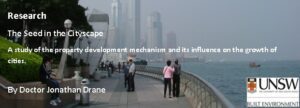
Property Development and the Growth of Cities (2015).The property development mechanism and its influence on the growth of cities. Models of the property development process by Dr Jonathan Drane.

A PHD Research Programme By Jonathan Drane, Doctoral Candidate UNSW Faculty of the Built Environment (2011 to 2014) The doctorate was conferred on 15 April 2015.
Link to UNSW Library for Published Doctorate
Summary Brochure on Thesis Download:
Drane 2012- Seed in City Brochure Summary
Abstract
Download: Drane 2014- Abstract Seed in the Cityscape
Property development transforms the face of our cities, and is responsible for many of the physical shells that form our skylines and their sometimes grandiose building forms. The property developer is a significant transactional actor in this phenomenon, the often un-popular gatekeeper who commands the mechanism, and a member of our society who primarily holds a key to a growing channel through which much of our cities must pass, to change and grow. As such, despite it being the realm of what is seen often as remote, romantic and even dangerous ‘archetypal’ characters, this mechanism enjoys a powerful and unique position in our urban creation and associated societal processes. Local authorities and their urban planners therefore, still continue to rely substantially on private commercial developers to provide new supply in housing and other building markets- a continuing point of contention in the planning and associated arenas.
The mechanism, its actors and drivers are represented in a transactional model which explains its catalytic effect on the proliferation of buildings in cityscapes, which have become obsolete or dilapidated, and in turn are rejuvenated in context with the fabric of the city that surrounds them. Such proliferations are proposed to be caused by the mechanism and its transactional elements.
Study Objectives
To explain the influence that the property development mechanism has on the growth of buildings in our cityscapes. The proposed model explains the dependency of our cities on the mechanism as a means of building supply, the outcomes of which are not always as envisaged in city plans and visions. The research provides a greater understanding of this phenomenon and informs future urban and growth theory of our cities.
Data Support
The explanatory model is built based on the writer’s collection of data from his involvement in the mechanism across several case examples over three decades, in obsolete/dilapidated and dynamic cityscapes.
The model is supported further by data collection through two contemporary case studies in Townsville. In one case (The Palmer St Precinct) the mechanism resulted in semi-obsolete land being changed into an active hotel and eat street precinct and the other case, (The Railway Land Precinct) activation did not proceed substantially, and the land remained partly undeveloped. The reasons for the latter are analysed to show the model’s relevance and dormant nature as a phenomenon ‘in waiting’. The mechanism in effect is proposed to act like a seed in the cityscape.
A further case study of the Honeysuckle Urban Renewal Project is undertaken to support the research. The precinct which lines the foreshore of Newcastle’s prior obsolete port areas, has seen development in a series of precincts since its Concept Master Plan was created in 1991. Like Townsville’ Palmer St precinct, both were stimulated by the Building Better Cities Programme of the early 1990’s. Each has since seen what the researcher describes as development in waves created by certain alignments. The mechanism as depicted by the research brings this to life.
Please note that this research process is undertaken based on the principles noted in the UNSW Faculty of Built Environment Human Research Ethics Advisory Panel.
Should you require further clarification independent of the researcher, you are able to contact the ethics panel independently.

